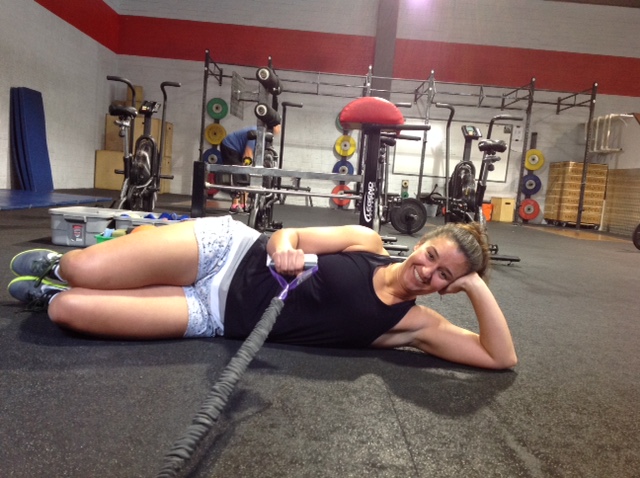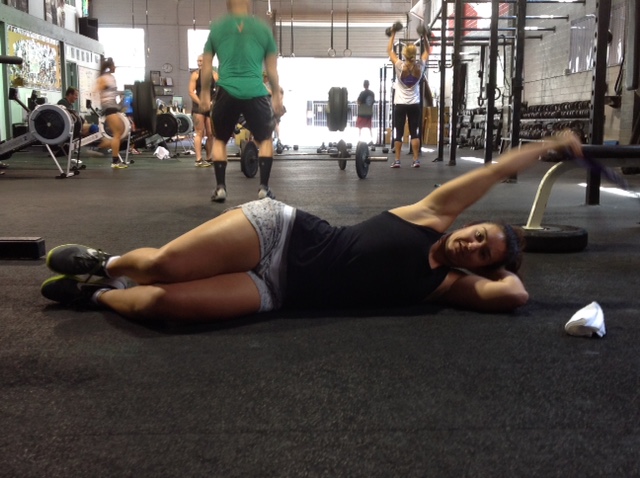Overactive Upper Trapezius Daily Solutions
Written by Melissa Hurley
What is the solution to all of the painful symptoms of an overactive upper trapezius? Relax the upper trap, reverse the compensation pattern, strengthen the rotator cuff and improve the scapular stabilizing muscle group’s activation and strength so the upper trap never has to compensate again.
Proper posture is very important to help prevent this injury from recurring. In our last post in this series (Postural Alignment Cues for Overactive Traps), we gave you specific focal points to improve and perfect your posture. In addition, try to keep your shoulders low throughout the day (maintain the space between the top of your shoulders and the bottom of your ear) when performing prolonged tasks such as painting, working at a computer, or driving.
It’s easy for our shoulders to creep up when tension builds. In addition to paying attention to positioning throughout the day, you can use a heating pad for 15-20 minutes and then stretch the muscles in your neck to gently to maintain and gain muscle flexibility.
At work, make sure to sit with an upright posture. You can use a “U” shaped travel pillow for neck feedback. You can also do some subtle exercises at your desk. Set a timer on your watch or cell phone and stay active while performing these movements for 15-20 reps of the following exercises every hour.
1. Scapular Pinches. Roll the shoulders back, and pinch the shoulder blades together.
2. Shoulder Shrugs. Raise the shoulders up toward the ears, then lower them back down.
3. Neck Side-Bending. Tilt one ear toward the shoulder, and hold briefly. Repeat on the opposite side.
4. Neck Rotation. Look over one shoulder, and pause briefly. Repeat on the opposite side.
If you feel tight or sore in the upper trapezius after any of the above movement-oriented exercises, perform 1–3 reps of the following static stretch below, holding each rep for 30 seconds.
5. Neck Side-Bending/Rotation Stretch.
-
In a standing or seated position, place the right hand on top of the head and let the left arm rest at the side.
-
Gently pull the head toward the right shoulder with the right hand.
-
Rotate the head down and look at the right hip. The stretch should be felt on the left side of the neck/shoulder area.
-
Repeat on the opposite side.
If your shoulders tend to round forward, the scapular pinch exercise and adding a pectoral stretch is very helpful. You can also take a lacrosse ball, placing both hands over the ball, dig into your pectorals and release the tissue.
In the gym the challenge is balance. Many shoulder-rotator cuff exercises can continue to excessively fire your already overactive upper trapezius. Now, don’t get me wrong, there is still a place and time to work your upper trap; but when it is always in control and under tension, you need some movements that help eliminate the use of it and allow for the infraspinatus, lower trapezius, rhomboids, latissimus dorsi, etc. to be the primary movers. Four specific exercises listed below have been shown to be great for restoration of muscle balance in the shoulders and helping to eliminate the upper trapezius.
Exercise: Side Lying External Rotation
Prep:
-
Lie on your side with legs separated for support.
-
Grasp dumbbell or cord and position elbow against side.
-
Forearm across belly.
Movement:
-
Lift dumbbell or cord by rotating shoulder.
-
Return and repeat.
-
Flip over and continue with opposite arm.
Focus: Maintain your elbow against your side with a fixed elbow position (90° angle) throughout exercise. Placing a towel roll under your arm increases use of infraspinatus and teres minor compared to no towel roll.
Exercise: Prone extension
Prep:
-
Either standing bent over at the waist or lying face down on a bench.
-
Your arm should hang freely off the side (ideally high enough that your arm is straight).
-
Grasp dumbbell or cord (pull from underneath bench).
Movement:
-
Set the shoulder blade down and back.
-
With a straight elbow, raise the arm backward towards your hip and the thumb pointing outward.
-
Don’t raise the hand past the level of your hip.
Focus: Keep shoulder blade set back and down while reaching the arm back towards hip.
Exercise: Side-lying forward flexion
Prep:
-
Lie on your side with your legs separated for support.
-
Grasp dumbbell or cord with a straight arm over head and in line with your body.
-
Thumb pointed to ground, palm facing forward.
-
Make sure hips and shoulders are in line with each other.
Movement:
-
Set shoulder blades back and down.
-
Keep midline braced, butt and belly tight.
-
With a straight arm, palm facing forward pull dumbbell/cord down towards hip, pull your pinky all the way to your hip.
-
Raise straight arm back to start position.
-
Keep the movement controlled.
Focus:
-
Shoulder blade set back and down.
-
Keep hips and shoulders in line and midline braced.
-
Move slow and controlled throughout the entire movement.
Exercise: Prone horizontal abduction with external rotation
Prep:
-
Either standing bent over at the waist or lying face down on a bench; ideally high enough that your arm is straight.
2. Your arm should hang freely off the side.
3. Hold a small DB or plate in your hand
Movement:
-
Raise your arm straight out (horizontal abduction), elbow straight, arm in line with shoulder.
-
Elbow and hand do not raise past the line of your body.
-
Initiate movement with scapular movement pulling that shoulder back and down.
-
Create space under the humeral head, off bench.
-
Raise arm up into shoulder flexion (upward rotation), keeping palm facing the ground and humeral head off the bench.
-
Pull back down to 90 degree and repeat upward rotation till fatigue.
Focus:
-
Maintain solid scapular control.
-
Keep humeral head off bench throughout movement up and down.
Your overactive trapezium can get better, the pain can go away. Stay focused on your daily posture, add some easy movements throughout your day, and when you go to the gym add these exercises. You can do too much. Stay tuned for stretches and mobility exercises to help relieve tension.
References
J Orthop Sports Phys Ther. 2009 Oct;39(10):743-52. doi: 10.2519/jospt.2009.3089.Trapezius muscle timing during selected shoulder rehabilitation exercises. De Mey K1, Cagnie B, Danneels LA, Cools AM, Van de Velde A.
J Orthop Sports Phys Ther. 2013 Jan;43(1):3-10. doi: 10.2519/jospt.2013.4283. Epub 2012 Nov 16. Conscious correction of scapular orientation in overhead athletes performing selected shoulder rehabilitation exercises: the effect on trapezius muscle activation measured by surface electromyography. De Mey K1, Danneels LA, Cagnie B, Huyghe L, Seyns E, Cools AM.
Clin Biomech (Bristol, Avon). 2014 Feb;29(2):201-5. doi: 10.1016/j.clinbiomech.2013.11.011. Epub 2013 Nov 26. Modifying a shrug exercise can facilitate the upward rotator muscles of the scapula. Pizzari T1, Wickham J2, Balster S3, Ganderton C4, Watson L5.
Logan, C. MSPT. Repetitive Stress Injury: The Upper Trapezius. IDEA Fitness Journal, Volume 3, Issue 8, 2006
Anderson, B. 1997. Stretching at Your Computer or Desk. Bolinas, CA: Shelter Publications Inc.; www.exrx.net. IDEA Fitness Journal , Volume 3, Issue 4, 2006 by IDEA Health & Fitness Inc.










Do you offer virtual training sessions?
Do you have a video of the exercises being done anywhere?
This needs to be edited to explain the prone extension better. There are so many variations and the instructions don’t say what to do past lifting your arms once. The photos show one arm raise in front but there is no mention of that in the instructions. No clue what you guys are saying. I’d make this regular but please explain 🙂
Just amazing exercises! It works! Thank you so much!
Great article, thanks! For the side-lying exercises, is there an advantage to doing them lying down versus standing up? Also for overactive traps do you recommend using a lacrosse ball for trigger point release in the back tissues? For me, sometimes that helps and other times it makes it worse…
Thanks so much for these exercises!! How many reps daily and how many days per week would you recommend?
Why are you doing shrugs, when shrugs activate the upper traps, which we don’t want for an overactive trap
Overactive trap should be strengthened, because it is weakened, so we should do shrughs etc.
Great article! However, I think on #5 Rotational Stretches when you wrote, “Rotate the head down and look at the right hip. The stretch should be felt on the left side of the neck/shoulder area.”
I think you need to look at the LEFT hip. The Upper Trapezius is a contralateral rotator, so a “perfect stretch” would involve looking at the same side.
Where are the stretches to help with tension
Thanks for doing this series! Huge help!!
Yay, so glad you’re enjoying
these exercises can be used during the warm-up?
Definitely. Have fun, hope they help